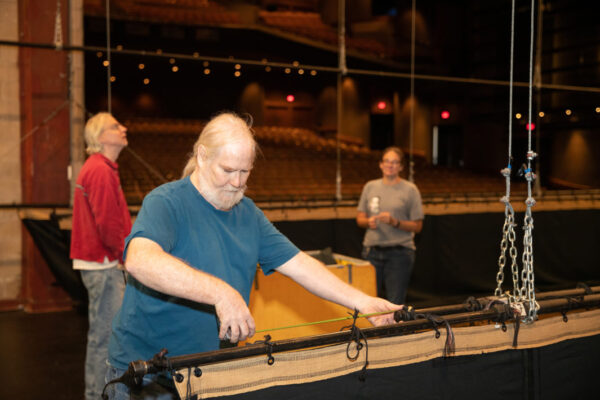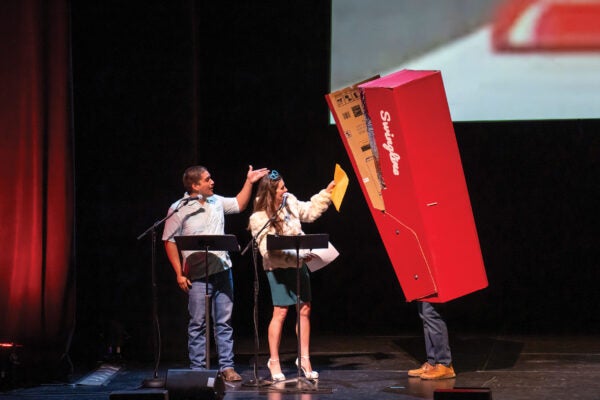On Oct. 28, trucks for “The Tonight Show Starring Jimmy Fallon” backed into the loading dock at Bass Concert Hall. Two days later, “The Daily Show” host Trevor Noah’s crew arrived and began unpacking truckloads of wheeled cases for his standup performance. Light and sound technicians dressed in black T-shirts and black jeans, armed with walkie-talkies and highly active cellphones, moved trusses through the windowless back corridors and onto the grand stage at Bass.
Fallon’s lighting was installed by his own contracted engineers, who collaborated with Texas Performing Arts’ master electricians, Sarah Cantu and Seb Boone, and lighting supervisor Jeff Ellinger. Once the wires were all connected, Cantu said they were ready to “go hot.” She pulled a throw switch, and the tests began.
The luxurious stage curtains at Bass not only stand as an anticipatory symbol but also keep the complex, intricate, fast-paced and sometimes overwhelming backstage hustle a mystery to the many visitors who come for a night of comedy, music or drama.
“In comparison to Broadway, this is way, way more intense because of the number of clients we service and the number of shows we bring. It’s a crazy amount of shows,” says Gene Bartholomew, director of marketing and communications for TPA.
Texas Performing Arts is a wheel that turns 365 days a year, and Bass is only one of its five venues – it also presents shows in McCullough Theatre, Bates Recital Hall, Oscar G. Brockett Theatre and B. Iden Payne Theatre.
A highly qualified and passionate team of about 50 staff members keeps that wheel turning; without constant orchestration from all departments, it would bend, wear and wobble.
“I spend a lot of time in meetings,” says Yvonne Kimmons, assistant director of performance logistics. “We plan out a year to two years from now.”

It starts with a calendar. Broadway gets first dibs because it schedules so far in advance. Next come the fine arts programs, part of TPA’s Essential Series. Finally, professional shows are booked in: Talk show hosts, comedians, concerts, South by Southwest installations, authors, Q&A’s and more are booked and “bought” by TPA’s talent buyer Will Shirey.
The marketing department goes to work with programming, brochures and advertisement distribution. The production team looks at logistics, costs and their own capacity to deliver what the show requires.
If certain needs cannot be executed, the production crew needs to craft a compelling alternative. For Kimmons, this can be the most challenging part of the job.
“We did ‘Let the Right One In,’” she says. A character in that show “has to drown on stage, and you have to see it happen. That’s a lot of water, and not only do they have to drown, but the water isn’t there all the time! (We had to figure out how to make it) suddenly appear and then suddenly go away.”
Down the hall from Bass’ main stage, storage boxes labeled WARTS!, EVE TOOLKIT, CHURCH RIGHT and more are stacked in piles.
Karen Maness, scenic art supervisor, and J.E. Johnson, scenic studio supervisor, each have been with TPA for about two decades. They design and craft scenes and sets with master carpenter Hank Schwemmer, and their department is the one that most actively works with students on set and costume designs, basic design engineering and execution of creative pieces.
TPA has a student engagement program that provides hands-on opportunities for students to learn the ropes of conducting a high-level performance.
“It’s not a job you actually study for,” says Conrad Haden, TPA’s stage supervisor and one of the longest serving staff members there. “The more you’re in the industry, the more knowledge you gain by doing things hands on.”
That opportunity to work with students is a draw for many staff members.
“There’s very, very low turnover in the production part of Texas Performing Arts,” Johnson says. “I’ve been here for 22 years. Our master carpenter has been here longer than me. Our scenic art supervisor, Karen, has been here just two or three years less (than I have). It’s a place that people tend to come and stay. The reason I’m still here is that I’m just so interested in how to engage young people in building things with their hands.”
TO SUCCEED, WE HAVE TO COLLABORATE. AND WE HAVE TO CREATE THIS ECOSYSTEM THAT IS SUPPORTIVE OF EACH OTHER AT ALL POINTS.
Haden was hired in 1980 when what was then called the Performing Arts Center of The University of Texas was preparing for its first season.
“We started into what we are now, which is a hybrid in the industry. We are a combination of both educational and professional,” Haden says.
Production needs reflect rapidly changing technologies and creative applications. Haden, who orchestrates the load-in and load-out processes of a show, was there in the early ’80s when Bob Hope filmed a live television program at what was then called the Grand Concert Hall.
“The one thing you can say is, they had cameras back then, and we have cameras now. It’s definitely not the same kind of animal it used to be,” Haden says.
All staff members at Texas Performing Arts mention two to three teammates who they believe are the real stars of the show.
“Dani Pruitt, Lindsay Long, and then of course our overall supervisors, Phoebe Greene and Yvonne Kimmons,” Haden says. “Basically, (Kimmons) is the one that keeps our madhouse together. Every week we have a meeting that covers the next five weeks out just to keep track of the shows coming.”
It can be a high-stress, high-adrenaline job. Kimmons says when they sit down at meetings, you might not think they all work exceptionally well together, but when it comes time for everything to come together, there is a dynamic that emerges to create the state-of-the-art show execution that thousands of guests witness from in front of that red curtain.
“I think it very much speaks to the culture of theater,” Maness says. “We understand for us to succeed, we have to collaborate. And we have to create this ecosystem that is supportive of each other at all points.”



